Martienssen W., Warlimont H. (Eds.). Handbook of Condensed Matter and Materials Data
Подождите немного. Документ загружается.


902
This page intentionally left blank

903
Ferroelectrics
4.5. Ferroelectrics and Antiferroelectrics
Ferroelectric crystals (especially oxides in the form
of ceramics) are important basic materials for
technological applications in capacitors and in
piezoelectric, pyroelectric, and optical devices. In
many cases their nonlinear characteristics turn
out to be very useful, for example in optical
second-harmonic generators and other nonlinear
optical devices. In recent decades, ceramic thin-
film ferroelectrics have been utilized intensively
as parts of memory devices. Liquid crystal and
polymer ferroelectrics are utilized in the broad
field of fast displays in electronic equipment.
This chapter surveys the nature of ferroelectrics,
making reference to the data presented in the
Landolt–Börnstein data collection Numerical
Data and Functional Relationships in Science
and Technology, Vol. III/36, Ferroelectrics and
Related Substances (LB III/36). The data in the
figures in this chapter have been taken mainly
from the Landolt–Börnstein collection. The
Landolt–Börnstein volume mentioned above
4.5.1 Definition of Ferroelectrics
and Antiferroelectrics ......................... 903
4.5.2 Survey of Research on Ferroelectrics ..... 904
4.5.3 Classification of Ferroelectrics .............. 906
4.5.3.1 The 72 Families of Ferroelectrics 909
4.5.4 Physical Properties of 43 Representative
Ferroelectrics ..................................... 912
4.5.4.1 Inorganic Crystals Oxides [5.1,2] 912
4.5.4.2 Inorganic Crystals
Other Than Oxides [5.3]............ 922
4.5.4.3 Organic Crystals, Liquid Crystals,
and Polymers [5.4] .................. 930
References .................................................. 936
consists of three subvolumes: Subvolume A [5.1,2],
covering oxides; Subvolume B [5.3], covering
inorganic crystals other than oxides; and Sub-
volume C [5.4], covering organic crystals, liquid
crystals, and polymers.
Matter consists of electrons and nuclei. Most of the elec-
trons generally are tightly bound to the nuclei, but some
of the electrons are only weakly bound or are freely mo-
bile in a lattice of ions. The physical properties of matter
can be considered as being split into two categories. The
properties in the first category are determined directly
by the electrons and by the interaction of the electrons
with lattice vibrations. Examples are the metallic, mag-
netic, superconductive, and semiconductive properties.
The properties in the second category are only indirectly
related to the electrons and can be discussed as being due
to interaction between atoms, ions, or molecules. In this
category we have, for example, the dielectric, elastic,
piezoelectric, and pyroelectric properties; we have the
dispersion relations of the lattice vibrations; and we have
most of the properties of liquid crystals and polymers.
The important properties of ferroelectrics are linked to
all the latter properties, and they exhibit diverse types of
phase transitions together with anomalies in these prop-
erties. These specific modifications convey information
about cooperative interactions among ions, atoms, or
molecules in the condensed phase of matter.
4.5.1 Definition of Ferroelectrics and Antiferroelectrics
A ferroelectric crystal is defined as a crystal which
belongs to the pyroelectric family (i. e. shows a spon-
taneous electric polarization) and whose direction of
spontaneous polarization can be reversed by an electric
field. An antiferroelectric crystal is defined as a crystal
whose structure can be considered as being composed
of two sublattices polarized spontaneously in antipar-
allel directions and in which a ferroelectric phase can
Part 4 5
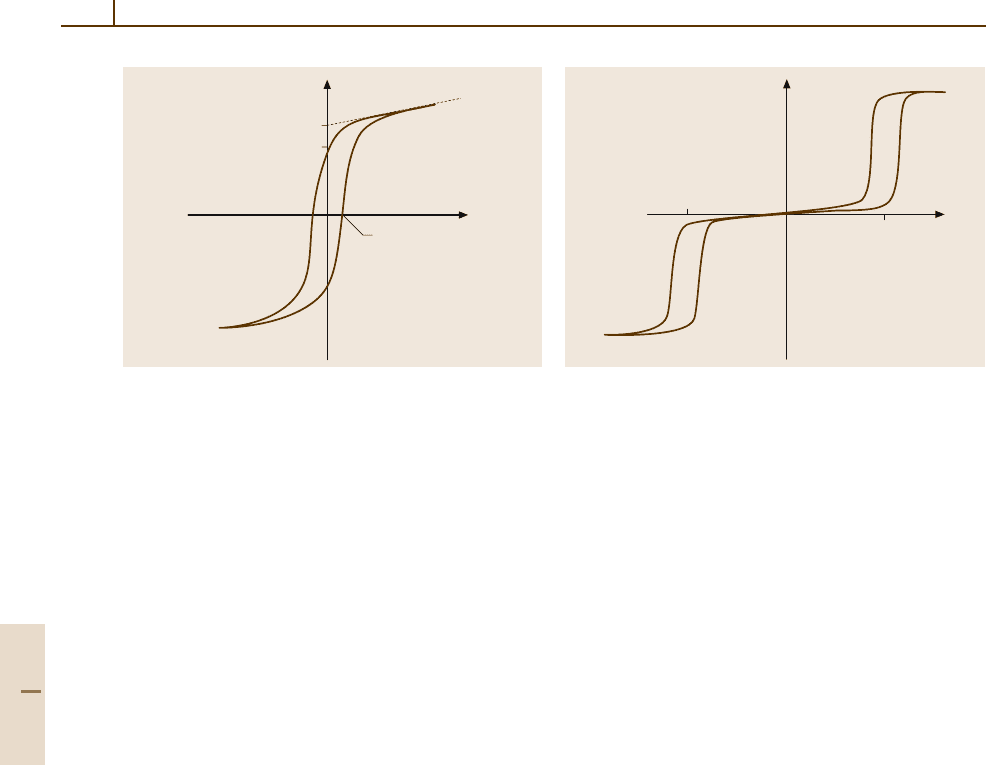
904 Part 4
P
P
s
P
r
E
c
E
Fig. 4.5-1 Ferroelectric hysteresis loop. P
s
, spontaneous
polarization; P
r
, remanent polarization; E
c
,coercivefield
be induced by applying an electric field. Experimen-
tally, the reversal of the spontaneous polarization in
ferroelectrics is observed as a single hysteresis loop
(Fig. 4.5-1), and the induced phase transition in antifer-
roelectrics as a double hysteresis loop (Fig. 4.5-2), when
a low-frequency ac field of a suitable strength is applied.
The spontaneous polarization in ferroelectrics and
the sublattice polarizations in antiferroelectrics are anal-
ogous to their magnetic counterparts. As described
above, however, these polarizations are a necessary
P
EE
crit
–E
crit
Fig. 4.5-2 Antiferroelectric hysteresis loop. E
crit
, critical
field
but not sufficient condition for ferroelectricity or an-
tiferroelectricity. In other words, ferroelectricity and
antiferroelectricity are concepts based not only upon the
crystal structure, but also upon the dielectric behavior
of the crystal. It is a common dielectric characteristic of
ferroelectrics and antiferroelectrics that, in a certain tem-
perature range, the dielectric polarization is observed to
be a two-valued function of the electric field.
The definition of ferroelectric liquid crystals needs
some comments; see remark l in Sect. 4.5.3.1.
4.5.2 Survey of Research on Ferroelectrics
The ferroelectric effect was discovered in 1920 by
Valasek, who obtained hysteresis curves for Rochelle
salt analogous to the B–H curves of ferromag-
netism [5.5], and studied the electric hysteresis and
piezoelectric response of the crystal in some detail [5.6].
For about 15 years thereafter, ferroelectricity was con-
sidered as a very specific property of Rochelle salt,
until Busch and Scherrer discovered ferroelectricity in
KH
2
PO
4
and its sister crystals in 1935. During World
War II, the anomalous dielectric properties of BaTiO
3
were discovered in ceramic specimens independently by
Wainer and Solomon in the USA in 1942, by Ogawa in
Japan in 1944, and by Wul and Goldman in Russia in
1946. Since then, many ferroelectrics have been discov-
ered and researchactivity has rapidlyincreased. In recent
decades, active studies have been made on ferroelectric
liquid crystals and high polymers, after ferroelectricity
had been considered as a characteristic property of solids
for more than 50 years.
Figures 4.5-3, 4.5-4, and 4.5-5 demonstrate how
ferroelectric research has developed. Figure 4.5-3 in-
dicates the number of ferroelectrics discovered each
year for oxide (Fig. 4.5-3a) and nonoxide ferroelectrics
(Fig. 4.5-3b). Figure 4.5-4 gives the total number of fer-
roelectrics known at the end of each year. At present
more than 300 ferroelectric substances are known. Fig-
ure 4.5-5 indicates the number of research papers on
ferroelectrics and related substances published each
year.
Advanced experimental methods (e.g. inelastic neu-
tron scattering and hyper-Raman scattering) have been
applied effectively to studies of ferroelectrics, and sev-
eral new concepts (e.g. soft modes of lattice vibrations
and the dipole glass) have been introduced to under-
stand the nature of ferroelectrics. Ferroelectric crystals
have been widely used in capacitors and piezoelec-
tric devices. Steady developments in crystal growth
and in the preparation of ceramics and ceramic thin
Part 4 5.2
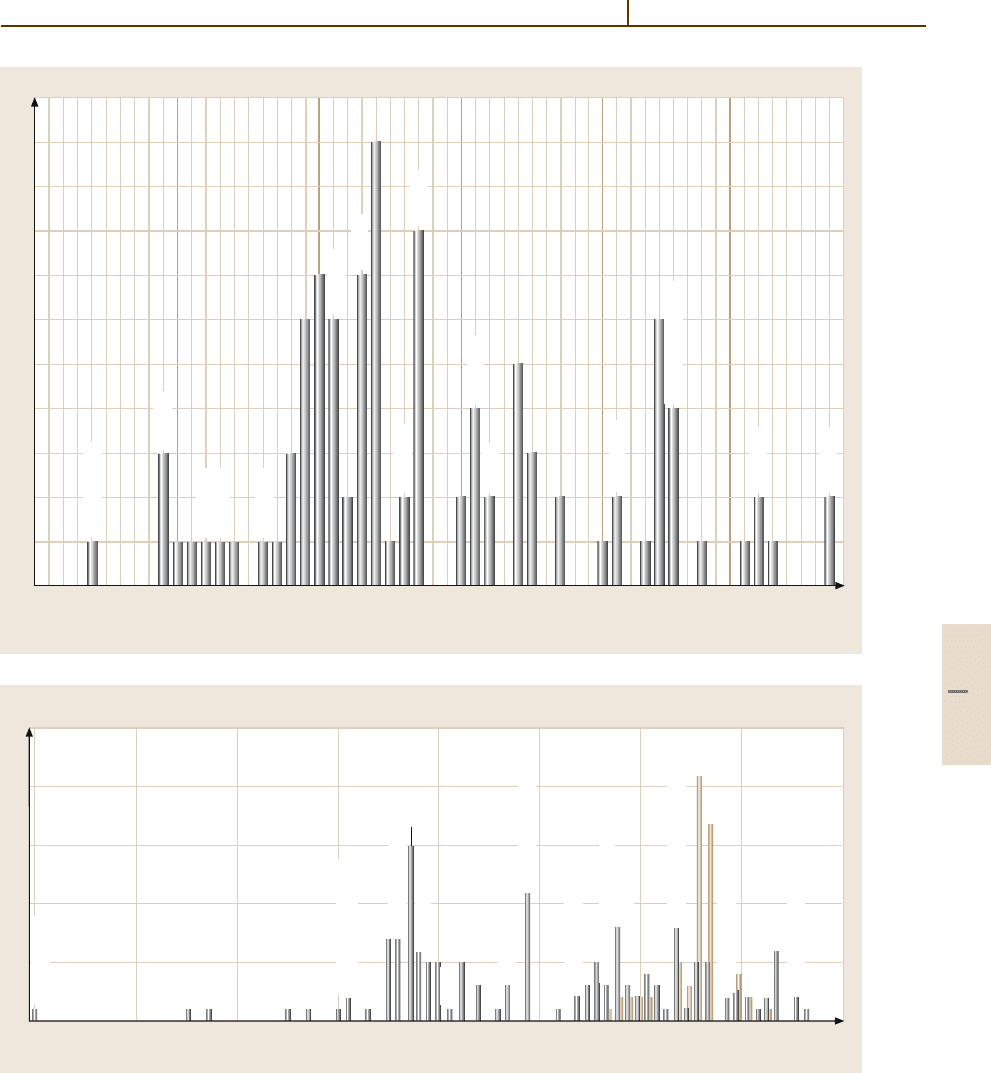
Ferroelectrics and Antiferroelectrics 5.2 Survey of Research on Ferroelectrics 905
a)
10
9
8
7
6
5
4
3
2
1
0
1940
1943
1946
1949
1952
1955
1958
1961
1964
1967
1970
1973
1976
1979
1982
1985
1988
1991
1994
1997
Number of oxide ferroelectrics
Year of discovery
cubic BaT
iO
cubic BaT
iO
cubic BaT
iO
3
LiNbLiNb
LiNb
OO
O
3
Cd
2
Nd
2
O
7
PbNb
2
O
6
Sr
2
Ta
2
O
7
Bi
4
Ti
3
O
12
YMnO
3
Ba
2
NaNb
5
O
15
Gd
2
(MoO
4
)
3
Pb
5
Ge
3
O
11
SrTeO
3
Li
2
Ge
7
O
15
hexagonal BaTiO
3
Li
2
Ge
4
O
9
GdMn
2
O
5
25
20
15
10
5
0
1920
1930 1940 1950 1960 1970 1980 1990
b)
Number of non-oxide ferroelectrics
Year of discovery
Rochelle salt
KDP
LiNH
4
C
4
H
4
O
6 ˙
H
2
O
TGS, (NH
4
)
2
SO
4
Alum
NaNO
2,
KNO
3
KIO
3
SbSI
HCl
K
2
SeO
4
, BaMgF
4
Sn
2
P
2
S
6
, PbHPO
4
Rb
2
ZnCl
4
, DOBAMBC
(CH
2
CF
2
)
n
CsCoPO
4,
HAOBAMBC
(CH
3
NH
3
)
6
Bi
2
Cl
11
TIS
(CH
3
)NH
2
H
2
PO
4
Fig. 4.5-3a,b Number of ferroelectric substances discovered in each year. Representative ferroelectrics are indicated at
their year of discovery.
(a) Oxide ferroelectrics. Only pure compounds are taken into account. (b) Nonoxide ferroelectrics.
Gray bars stand for nonoxide crystals, counting each pure compound as one unit. Brown bars stand for liquid crystals
and polymers, counting each group of homologues (cf. Chaps. 71 and 72 in [5.4]) as one unit. The figure was prepared
by Prof. K. Deguchi using data from LB III/36
Part 4 5.2
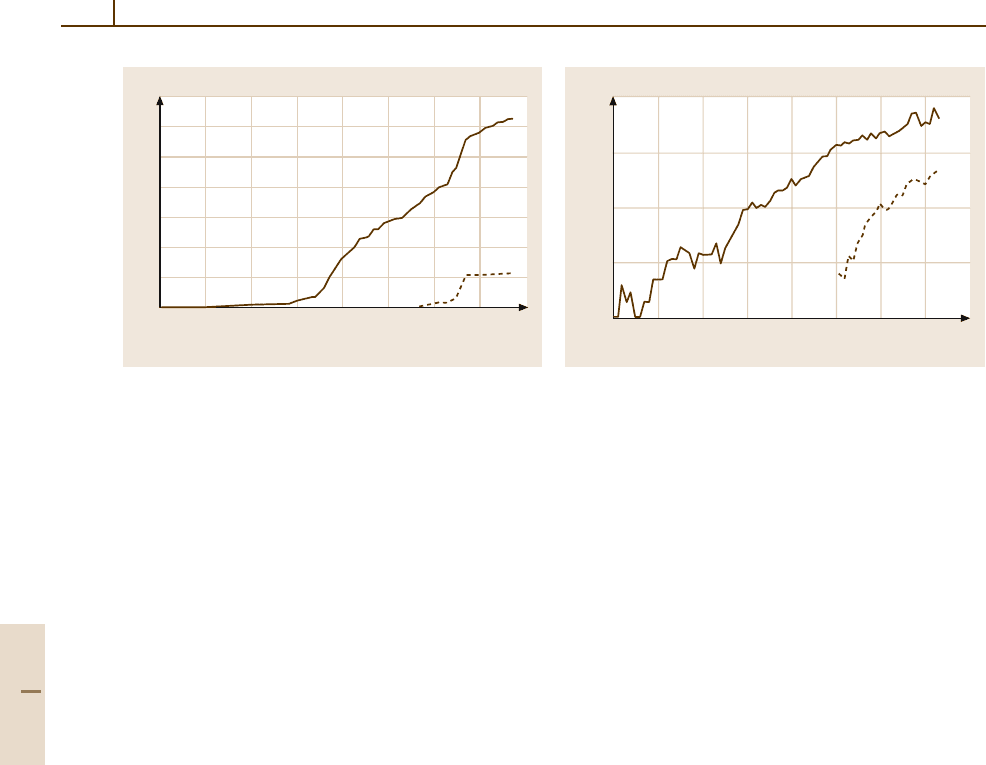
906 Part 4
350
300
250
200
150
100
50
0
1940
1950
1960
1970
1980
1990
2000
1930
1920
Number of ferroelectrics
Year
Fig. 4.5-4 Number of ferroelectric substances known at
the end of each year. The solid line represents all ferro-
electrics, including liquid crystals and polymers. For liquid
crystals andpolymers, each group of homologuesis counted
as one substance. The dashed line represents ferroelectric
liquid crystals and polymers alone. Figure prepared by Prof.
K. Deguchi
films have opened the way to various other applications
(e.g. second-harmonic generation and memory devices).
Liquid crystals and high-polymer ferroelectrics are very
useful as fast display elements.
Corresponding to this intense development, many
textbooks, monographs, and review articles have been
published on ferroelectric research during recent years.
Some of them, arranged according to the various re-
search fields, are listed here:
•
Introduction to ferroelectrics: [5.7–10]
•
Applications in general: [5.10,11]
•
Piezoelectricity: [5.12–14]
•
Structural phase transitions: [5.15–17]
•
Incommensurate phases: [5.18]
10 000
1000
100
10
1
1940 1950 1960 1970 1980 1990
2000
1930
1920
Number of papers
Year
Fig. 4.5-5 Number of research papers on ferroelectrics
and related substances published in each year. The solid
line indicates the number of papers concerning all fer-
roelectrics (crystals + liquid crystals + polymers). The
dashed line indicates the number of papers concerning
liquid crystals and polymers alone. Prepared by Prof.
K. Deguchi
•
Soft-mode spectroscopy: [5.19]
•
Inelastic neutron scattering studies of ferroelec-
trics: [5.20]
•
Raman and Brillouin scattering: [5.21]
•
Ceramic capacitors: [5.22]
•
Dipole glasses: [5.23]
•
Relaxors: [5.24]
•
Second-harmonic generation (SHG): [5.25–28]
•
Ferroelectric ceramics: [5.29]
•
Thin films: [5.30–35]
•
Acoustic surface waves (ASWs): [5.36–39]
•
Ferroelectric transducers and sensors: [5.40]
•
Memory applications: [5.35]
•
Ferroelectric liquid crystals: [5.41–47]
•
Ferroelectric polymers: [5.48–51]
4.5.3 Classification of Ferroelectrics
Ferroelectricity is caused by a cooperative interaction of
molecules or ions in condensed matter. The transition
to ferroelectricity is characterized by a phase transition.
Depending on the mechanism of how the molecules or
ions interact in the material, we can classify the fer-
roelectric phase transitions and also the ferroelectric
materials themselves into three categories: (I) order–
disorder type, (II) displacive type, and (III) indirect
type. In the order–disorder type (I), the spontaneous
polarization is caused by orientational order of dipolar
molecules, which is best visualized by the Ising model.
The dielectric constants of order–disorder type ferro-
electrics increase markedly in the vicinity of the Curie
point. In the displacive type (II), the spontaneous polar-
ization results from softening of the transverse optical
modes of the lattice vibrations at the origin of the Bril-
louin zone; again, a marked increase of the dielectric
constants is observed near the Curie temperature. The
Part 4 5.3
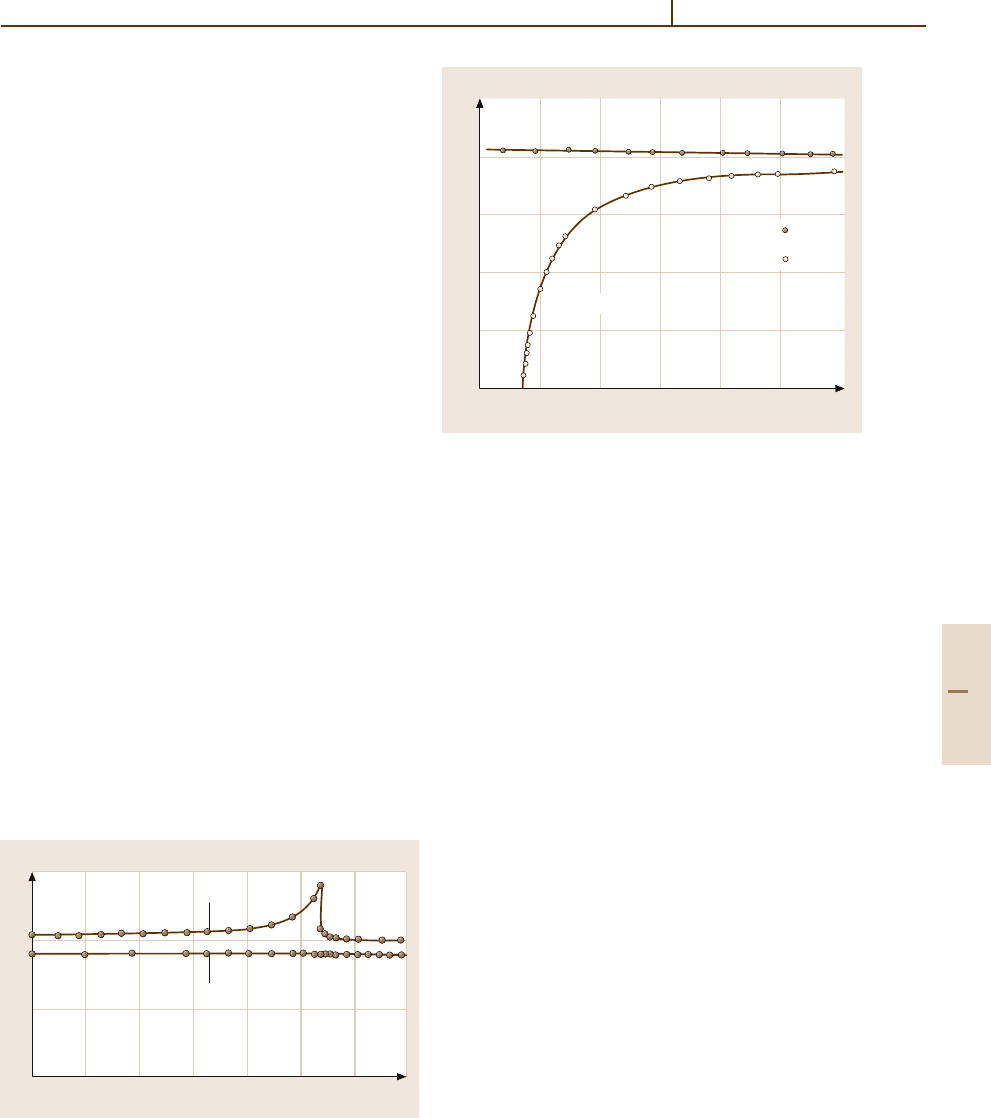
Ferroelectrics and Antiferroelectrics 5.3 Classification of Ferroelectrics 907
indirect type (III) is further classified into III
op
and III
ac
.
In type III
op
, the phase transition is originally caused
by softening of the optical modes at the Brillouin zone
boundary; a coupling of the soft modes with the elec-
tric polarization (through a complex mechanism) causes
the spontaneous polarization (e.g. substance 18, GMO,
in Sect. 4.5.4.1); only a very slight anomaly of the di-
electric constants is observed above the Curie point
(see Fig. 4.5-6). In type III
ac
, softening of the acoustic
modes (decrease of the tangent of the dispersion rela-
tion) takes place at the origin of the Brillouin zone, and
a piezoelectric coupling between the soft modes and
the polarization results in the spontaneous polarization
(e.g. substance 40, LAT, in Sect. 4.5.4.3). No dielectric-
constant anomaly appears above the Curie temperature
when the crystal is clamped so that elastic deformation
is prohibited (see Fig. 4.5-7). Most of the nonoxide fer-
roelectrics are of the order–disorder type and most of
the oxide ferroelectrics are of the displacive type, while
a few ferroelectrics are of the indirect type.
It might be expected that the dielectric disper-
sion would be dissipative and occur at relatively low
frequency (e.g. in the microwave region) in the order–
disorder ferroelectrics, while the dispersion would be
of the resonance type and occur in the millimeter or
infrared region in the displacive ferroelectrics. Actu-
ally, however, the situation is more complex owing to
phonon–phonon coupling and cluster formation near
the Curie temperature. Phonon–phonon coupling is
inevitable in displacive ferroelectrics because their fer-
roelectricity is closely related to the anharmonic term
of the ion potential, as first pointed out by Slater
(see [5.7]). Accordingly, the resonance-type oscilla-
tion tends to be overdamped. High dielectric constants
κ
25
12
10
8
6
50
75 100 125 150 175 200
T (°C)
κ
T
c
κ
S
c
Fig. 4.5-6 Gd
2
(MoO
4
)
3
. κ
T
c
,andκ
S
c
versus T . κ
T
c
is the
free dielectric constant κ
c
measured at 1 kHz, and κ
S
c
is the
clamped dielectric constant κ
c
measured at 19 MHz
2.5
2.0
1.5
1.0
0.5
0
(arb. units)
90
100 110 120 130 140 150
f = 2 MHz
T (K)
κ
22
κ
11
S
1/
1/
κ
11
T
1/
Fig. 4.5-7 LiNH
4
C
4
H
4
O
6
· H
2
O. 1/κ
S
22
,and1/κ
T
22
versus
T . κ
22
= κ
b
. f = 2MHz.κ
S
22
is κ
22
of the clamped crystal.
κ
T
22
is κ
22
of the free crystal
tend to induce the formation of clusters in which unit
cell polarizations are aligned, similarly to the domains
in the ferroelectric phase, but the boundaries of these
clusters fluctuate thermally. Inelastic neutron, hyper-
Raman, and hyper-Rayleigh scattering, etc. indicate the
existence of such clusters in several displacive ferro-
electrics. It is known that a ferromagnetic domain wall
can move to follow an ac magnetic field and contribute
to the magnetic susceptibility, while a ferroelectric do-
main wall usually cannot follow an ac electric field
and in practice does not contribute to the dielectric
constant. The cluster boundaries, however, fluctuate
thermally and hence will be able to follow an ac elec-
tric field and contribute to the dielectric constant. This
contribution will be dissipative in its character. Accord-
ingly, it is possible that dielectric dispersion occurs
as a combination of an overdamped-resonance disper-
sion and a dissipative dispersion in most displacive
ferroelectrics.
In second-order or nearly second-order phase tran-
sitions, the dielectric dispersion is observed to show
a critical slowing-down: a phenomenon in which the re-
sponse of the polarization to a change of the electric
field becomes slower as the temperature approaches the
Curie point. Critical slowing-down has been observed in
the GHz region in several order–disorder ferroelectrics
(e.g. Figs. 4.5-8 and 4.5-9) and displacive ferroelectrics
(e.g. Fig. 4.5-10). The dielectric constants at the Curie
point in the GHz region are very small in order–disorder
Part 4 5.3
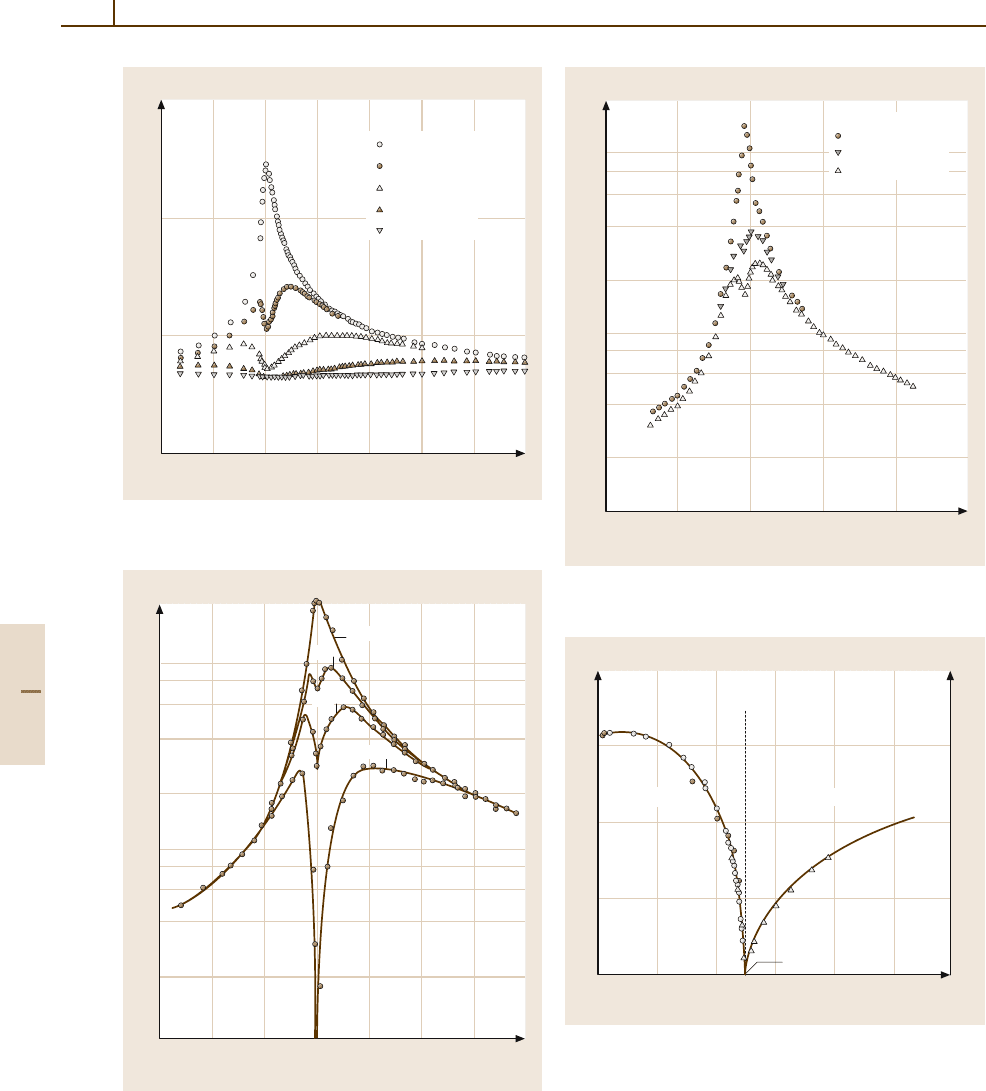
908 Part 4
–5 30
10
3
10
2
10
1
0 5 10 15 20 25
κ
c
'
T (°C)
f = 1.0 MHz
24.0 MHz
95.5 MHz
331.0 MHz
1000.0 MHz
Fig. 4.5-8 Ca
2
Sr(CH
3
CH
2
COO)
6
. κ
c
versus T . Param-
eter: f
0
10
3
10
2
10
8
6
4
2
40 45 50 55 60 65 70
8
6
4
2
T (°C)
κ
b
'
0.5 GHz
1.2
2.0
4.5 GHz
Fig. 4.5-9 (NH
2
CH
2
COOH)
3
· H
2
SO
4
. κ
b
versus T rela-
tion, showing critical slowing-down. Parameter: f
10
3
10
2
10
6
4
2
8
130.0
6
4
2
8
130.5 131.5 132.0 132.5
f = 36.3 MHz
f = 660.6 MHz
f = 1.0 GHz
T (K)
κ
b
'
131.0
Fig. 4.5-10 (CH
3
NHCH
2
COOH)
3
· CaCl
2
. κ
b
versus T .
Parameter: f . Critical slowing-down takes place
0 50 100 150 200 250 300
12
9
6
3
0
40
30
20
10
0
ν
0
(10
11
Hz) ν
0
/c (cm
–1
)
T (K)
Θ
f
C
9
2v
D
16
2h
A
1
(TO) B
2u
(TO)
Fig. 4.5-11 (CH
3
NHCH
2
COOH)
3
· CaCl
2
. ν
0
versus T .
ν
0
is the phonon mode frequency. Triangles: measured by
millimeter spectroscopy. Brown circles: measured from far-
infrared spectra. Gray circles: measured from electric-field-
induced Raman spectra. In the paraelectric phase (T >Θ
f
),
ν
0
decreases as the temperature decreases toward Θ
f
,that
is, the phonon mode softens
Part 4 5.3

Ferroelectrics and Antiferroelectrics 5.3 Classification of Ferroelectrics 909
ferroelectrics, as seen in Figs. 4.5-8 and 4.5-9. The di-
electric constant at the Curie point at 1 GHz is not so
small in displacive ferroelectrics, as seen in Fig. 4.5-10,
where the critical slowing-down seems to be related to
cluster boundary motion, and the dielectric constant at
the Curie point at 1 GHz contains a contribution from
the soft phonon as observed in millimeter spectroscopy
(Fig. 4.5-11).
4.5.3.1 The 72 Families of Ferroelectrics
In the Landolt–Börnstein data collection, ferroelec-
tric and antiferroelectric substances are classified into
72 families according to their chemical composition and
their crystallographic structure. Some substances which
are in fact neither ferroelectric nor antiferroelectric but
which are important in relation to ferroelectricity or anti-
ferroelectricity, for instance as an end material of a solid
solution, are also included in these families as related
substances. This subsection surveys these 72 families
of ferroelectrics presented in Landolt–Börnstein Vol.
III/36 (LB III/36). Nineteen of these families concern
oxides [5.1, 2], 30 of them concern inorganic crys-
tals other than oxides [5.3], and 23 of them concern
organic crystals, liquid crystals, and polymers [5.4].
Table 4.5-1 lists these families and gives some infor-
mation about each family. Substances classified in LB
III/36 as miscellaneous crystals (outside the families)
are not included.
In the following, remarks are made on 13 of the
families, labeled by the letters a – m in Table 4.5-1.
The corresponding family numbers are repeated in the
headings.
a. Perovskite-Type Family (Family Number 1). The
name of this group is derived from the mineral per-
ovskite (CaTiO
3
). The perovskite-type oxides are cubic
(e.g. CaTiO
3
above 1260
◦
C and BaTiO
3
above 123
◦
C)
or pseudocubic with various small lattice distortions
(e.g. CaTiO
3
below 1260
◦
C and BaTiO
3
below 123
◦
C).
Ceramics made from solid solutions of perovskite-
type oxides are the most useful ferroelectrics in
high-capacitance capacitors, piezoelectric elements, and
infrared sensors. Ceramic thin films are useful in mem-
ory devices.
The pure compounds are divided into simple
perovskite-type oxides and complex perovskite-type
oxides. Simple perovskite-type oxides have the
chemical formula A
1+
B
5+
O
3
or A
2+
B
4+
O
3
.Com-
plex perovskite-type oxides have chemical formu-
las expressed by (A
1+
1/2
A
3+
1/2
)BO
3
,A
2+
(B
2+
1/2
B
6+
1/2
)O
3
,
A
2+
(B
3+
1/2
B
5+
1/2
)O
3
,A
2+
(B
2+
1/3
B
5+
2/3
)O
3
,A
2+
(B
3+
2/3
B
6+
1/3
)O
3
,
A(B, B
,B
)O
3
,or(A, A
)(B, B
)O
3
. Among the com-
plex perovskite-type oxides, most of the Pb(B, B
)O
3
-
type oxides show a diffuse phase transition such that
the transition point is smeared out over a relatively
wide temperature range and exhibits a characteristic di-
electric relaxation; these materials therefore are called
“relaxors”.
b. LiNbO
3
Family (Family Number 2). This family con-
tains LiNbO
3
and LiTaO
3
. Their chemical formulas are
similar to those of the simple perovskite oxides, but their
structures are trigonal, unlike the perovskite oxides.
c. Stibiotantalite Family (Family Number 5). The
members of this family are isomorphous with the
mineral stibiotantalite Sb(Ta, Nb)O
4
. They have the
common chemical formula ABO
4
, where A stands for
Sc, Sb, or Bi and B for Ta, Nb, or Sb.
d. Tungsten Bronze-Type Family (Family Number 6).
The tungsten bronzes are a group of compounds hav-
ing the chemical formula M
x
WO
3
, where M stands
for an alkali metal, an alkaline earth metal, Ag,
Tl,etc.(e.g.Na
x
WO
3
, where x = 0.1–0.95). Most
of them exhibit a bronze-like luster. The tungsten
bronze-type oxides consist of crystals isomorphous
with tungsten bronze, including a simple type (e.g.
Pb
1/2
NbO
3
) and a complex type (e.g. Ba
2
NaNb
5
O
15
).
Single crystals (not ceramics) are used for technological
applications.
e. Pyrochlore-Type Family (Family Number 7). The
members of this family are isomorphous with the min-
eral pyrochlore, CaNaNb
2
O
6
F. Most of the members
have the general chemical formula A
2
B
2
O
7
or A
2
B
2
O
6
(anion-deficient compounds), where A stands for Cd,
Pb, Bi, etc. and B for Nb, Ta, etc.
f. Sr
2
Nb
2
O
7
Family (Family Number 8). This fam-
ily contains high-temperature ferroelectrics such as
Nb
2
Ti
2
O
7
and La
2
Ti
2
O
7
. Their Curie points are higher
than 1500
◦
C.
g. Layer-Structure Family (Family Number 9). The
common chemical formula of these oxides is
(Bi
2
O
2
)(A
n−1
B
n
O
3n−1
), where A stands for Ca, Sr,
Ba, Pb, Bi, etc., B stands for Ti, Nb, Ta, Mo, W, etc.,
and n varies from 1 to 9. The crystal structure is a re-
peated stacking of a layer of (Bi
2
O
2
)
2+
and a layer of
(A
n−1
B
n
O
3n−1
)
2−
, which can be approximately repre-
Part 4 5.3
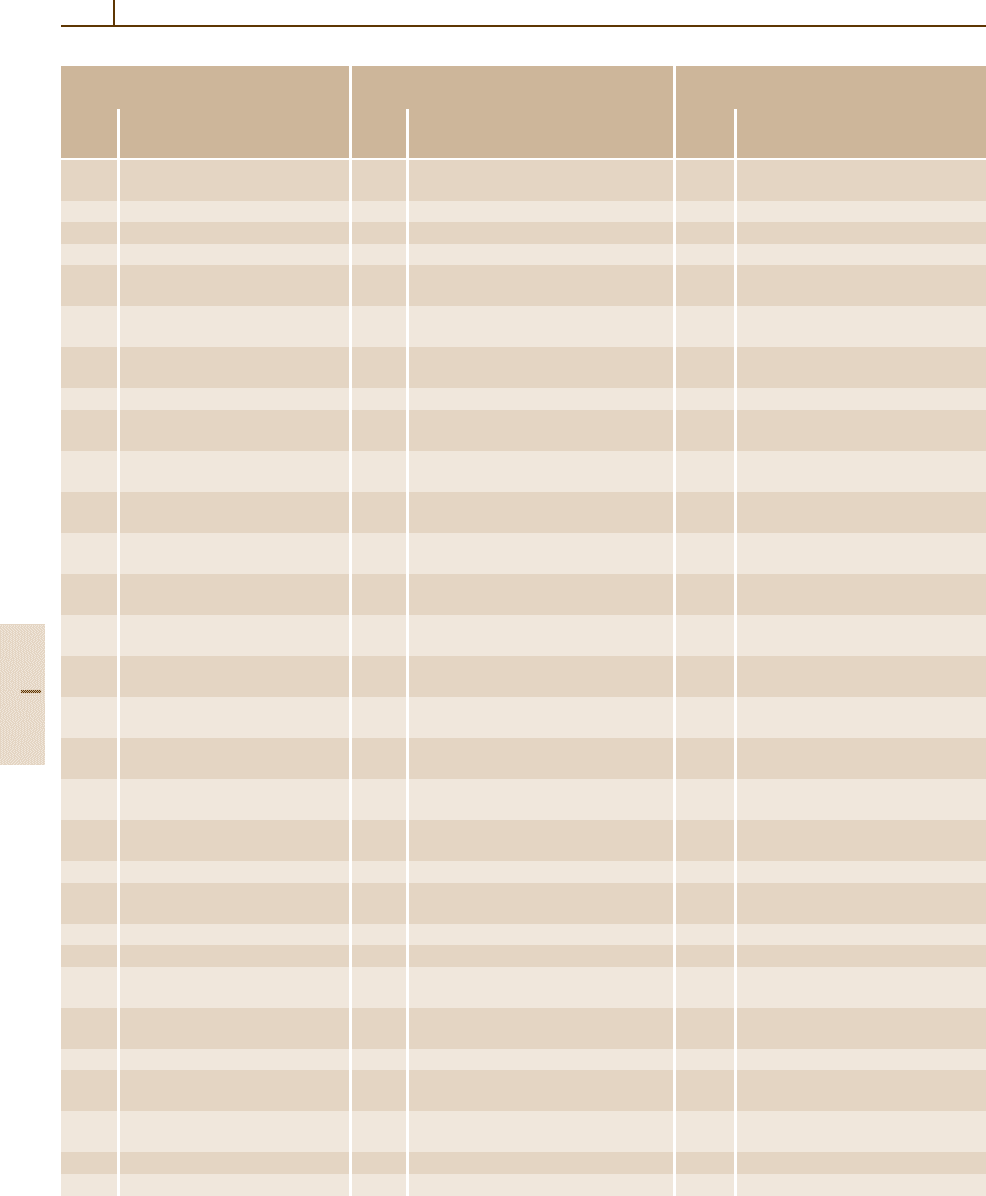
910 Part 4
Inorganic Crystals Inorganic Crystals Organic Crystals, Liquid Crystals,
Oxides [5.1, 2]
other than Oxides [5.3] and Polymers [5.4]
Family
Name Family Name Family Name
Nr. Nr. Nr.
1 Perovskite-type family 20 SbSI family (11, 4; 1) 50 SC(NH
2
)
2
family (1, 1; 1)
(90, 40; 11) a
2 LiNbO
3
family (2, 2; 1) b 21 TlS family (1, 1; 0) 51 CCl
3
CONH
2
family (1, 1; 0)
3 YMnO
3
family (6, 6; 0) 22 TlInS
2
family (5, 2; 0) 52 Cu(HCOO)
2
· 4H
2
O family (1, 1; 0)
4 SrTeO
3
family (1, 1; 1) 23 Ag
3
AsS
3
family (2, 1; 0) 53 N(CH
3
)
4
HgCl
3
family (6, 5; 0)
5 Stibiotantalite family (7, 6; 0) c 24 Sn
2
P
2
S
6
family (2, 2; 0) 54 (CH
3
NH
3
)
2
AlCl
5
· 6H
2
O
family (3, 2; 0)
6 Tungsten bronze-type family 25 KNiCl
3
family (3, 3; 0) 55 [(CH
3
)
2
NH
2
]
2
CoCl
4
(141, 21; 2) d family (3, 2; 0)
7 Pyrochlore-type family 26 BaMnF
4
family (6, 6; 1) 56 [(CH
3
)
2
NH
2
]
3
Sb
2
Cl
9
(19, 2; 0) e family (5, 5; 0)
8 Sr
2
Nb
2
O
7
family (6, 5; 1) f 27 HClfamily(2,2;1) 57 (CH
3
NH
3
)
5
Bi
2
Cl
11
family (2, 2; 0)
9 Layer-structure family 28 NaNO
2
family (2, 2; 1) 58 DSP (Ca
2
Sr(CH
3
CH
2
COO)
6
)
(36, 16; 0) g family (3, 3; 1)
10 BaAl
2
O
4
-type family (1, 1; 0) 29 CsCd(NO
2
)
3
family (2, 2; 0) 59 (CH
2
ClCOO)
2
H · NH
4
family (2, 2; 0)
11 LaBGeO
5
family (1, 1; 0) 30 KNO
3
family (4, 3; 1) 60 TGS ((NH
2
CH
2
COOH)
3
· H
2
SO
4
)
family (3, 3; 1)
12 LiNaGe
4
O
9
family (2, 2; 0) 31 LiH
3
(SeO
3
)
2
family (7, 5; 0) 61 NH
2
CH
2
COOH · AgNO
3
family (1, 1; 0)
13 Li
2
Ge
7
O
15
family (1, 1; 1) 32 KIO
3
family (3, 3; 0) 62 (NH
2
CH
2
COOH)
2
· HNO
3
family (1, 1; 0)
14 Pb
5
Ge
3
O
11
family (1,1; 0) 33 KDP (KH
2
PO
4
) family (12, 12; 3) 63 (NH
2
CH
2
COOH)
2
· MnCl
2
· 2H
2
O
family (1, 1; 0)
15 5PbO · 2P
2
O
5
family (1, 1; 0) 34 PbHPO
4
family (2, 2; 1) 64 (CH
3
NHCH
2
COOH)
3
· CaCl
2
(exact chemical formula unknown) family (2, 2; 1)
16 Ca
3
(VO
4
)
2
family (2, 2; 0) 35 KTiOPO
4
family (23, 15; 0) 65 (CH
3
)
3
NCH
2
COO · H
3
PO
4
family (3, 3; 0)
17 GMO (Gd
2
(MoO
4
)
3
) 36 CsCoPO
4
family (5, 5; 0) 66 (CH
3
)
3
NCH
2
COO · CaCl
2
· 2H
2
O
family (5, 5; 1) family (1, 1; 1)
18 Boracite-type family (28, 14; 1) h 37 NaTh
2
(PO
4
)
3
family (2, 2; 0) 67 Rochelle salt (NaKC
4
H
4
O
6
· 4H
2
O)
family (3, 2; 1)
19 Rb
3
MoO
3
F
3
family (4.4; 0) 38 Te (OH)
6
· 2NH
4
H
2
PO
4
68 LiNH
4
C
4
H
4
O
6
· H
2
O
· (NH
4
)
2
HPO
4
family (1, 1; 0) family (3, 2; 1) k
39 (NH
4
)
2
SO
4
family (22, 21; 1) 69 C
5
H
6
NBF
4
family (1, 1; 0)
40 NH
4
HSO
4
family (9, 4; 1) 70 3C
6
H
4
(OH)
2
· CH
3
OH family
(1, 1; 0)
41 NH
4
LiSO
4
family (9, 6; 1) 71 Liquid crystal family (97, 90; 2) l
42 (NH
4
)
3
H(SO
4
)
2
family (2, 2; 1) 72 Polymer family (5, 5; 1) m
43 Langbeinite-type
family (16, 5; 1) i
44 Lecontite (NaNH
4
SO
4
· 2H
2
O)
family (2, 2; 0)
45 Alum family (16, 15; 0) j
46 GASH (C(NH
2
)
3
Al(SO
4
)
2
· 6H
2
O) family (9, 9; 0)
47 Colemanite (Ca
2
B
6
O
11
· 5H
2
O) family
(1, 1; 0)
48 K
4
Fe(CN)
6
· 3H
2
O family (4, 4; 0)
49 K
3
BiCl
6
·2KCl ·KH
3
F
4
family (1, 1; 0)
Part 4 5.3

Ferroelectrics and Antiferroelectrics 5.3 Classification of Ferroelectrics 911
Table 4.5-1 The 72 families of ferroelectric materials. The number assigned to each family corresponds to the number
used in LB III/36. The numbers in parentheses (N
Sub
, N
F+A
; n) after the family name serve the purpose of conveying
some information about the size and importance of the family. The numbers indicate the following: N
Sub
, the number of
pure substances (ferroelectric, antiferroelectric, and related substances) which are treated as members of this family in
LB III/36; N
F+A
, the number of ferroelectric and antiferroelectric substances which are treated as members of this family
in LB III/36; n, the number of representative substances from this family whose properties are surveyed in Sect. 4.5.4.
For some of these families, additional remarks are needed: for instance, because the perovskite-type oxide family has
many members and consists of several subfamilies; because the liquid crystal and polymer families have very specific
properties compared with crystalline ferroelectrics; and because the traditional names of some families are apt to lead to
misconceptions about their members. Such families are marked by letters a–m following the parentheses, and remarks on
these families are given under the corresponding letter in the text in Sect. 4.5.3.1
sented by a chain of n perovskite-type units of ABO
3
perpendicular to the layer.
h. Boracite-Type Family (Family Number 18). Bo-
racite is a mineral, Mg
3
B
7
O
13
Cl. The boracite-type
family contains crystals isomorphous with the mineral,
and has the chemical formula M
2+
3
B
7
O
13
X
1−
, where
M
2+
stands for a divalent cation of Mg, Cr, Mn, Fe, Co,
Ni, Cu, Zn, or Cd, and X
1−
stands for an anion of Cl,
Br, or I.
i. Langbeinite-Type Family (Family Number 43). This
family consists of crystals which are basically iso-
morphous with K
2
Mg
2
(SO
4
)
3
(langbeinite), and have
the common chemical formula M
1+
2
M
2+
2
(SO
4
)
3
, where
M
1+
stands for a monovalent ion of K, Rb, Cs, Tl, or
NH
4
, and M
2+
stands for a divalent ion of Mg, Ca, Mn,
Fe, Co, Ni, Zn, or Cd.
j. Alum Family (Family Number 45). The alums are
compounds with the chemical formula M
1+
M
3+
(SO
4
)
2
·12 H
2
O, where M
1+
is a monovalent cation and M
3+
is a trivalent cation. Ferroelectricity has been found
for the monovalent cations of NH
4
,CH
3
NH
3
,etc.
and the trivalent cations of Al, V, Cr, Fe, In, and
Ga. This family contains a few isomorphous selenates,
M
1+
M
3+
(SeO
4
)
2
·12 H
2
O.
k. LiNH
4
C
4
H
4
O
6
·H
2
O Family (Family Number 68). This
family containstwo ferroelectrics, LiNH
4
C
4
H
4
O
6
·H
2
O
and LiTlC
4
H
4
O
6
·H
2
O. The polar directions of the two
ferroelectrics are different from each other.
l. Liquid Crystals (Family Number 71). Ferroelectric
and antiferroelectric liquid crystals are very useful as
fast display elements.
A. Ferroelectric liquid crystals (family number 71A).
Ferroelectric liquid crystals are defined as liquid
crystals which exhibit a ferroelectric hysteresis loop
like that shown in Fig. 4.5-1. Unlike ferroelectric
crystals, however, ferroelectric liquid crystals gen-
erally have no spontaneous polarization in the bulk
state. The chiral smectic phase denoted by Sm C
∗
(e.g. of DOBAMBC) consists of many layers, each
of which has a spontaneous polarization parallel to
the layer plane, but the spontaneous polarization
varies helically in different directions from layer
to layer, so that the bulk has no spontaneous po-
larization as a whole. A sufficiently strong electric
field causes a transition from the helical phase to
a polar phase. Under an alternating electric field, the
helical structure does not have a chance to build
up owing to the delay in the transition. Instead,
a direct transition occurs between the induced po-
lar phases, resulting in a hysteresis loop of the
type shown in Fig. 4.5-1. Accordingly, the hysteresis
loop may be regarded as one in which the lin-
ear part of the antiferroelectric hysteresis shown in
Fig. 4.5-2 is eliminated. It should be noted, how-
ever, that the helical structure disappears and two
stable states with parallel and antiparallel polar-
izations appear, similar to the domain structure
of a ferroelectric crystal, when a liquid crystal
is put in a cell which is thinner than the helical
pitch [5.52].
B. Antiferroelectric liquid crystals (family number
71B). The phase denoted by Sm C
∗
A
(e.g. of MH-
POBC) exhibits a double hysteresis of the type
shown in Fig. 4.5-2, and a liquid crystal showing
this phase is called antiferroelectric [5.53].
m. Polymers (Family Number 72). Polyvinylidene flu-
oride (CH
2
CF
2
)
n
and its copolymers with trifluoroethy-
lene (CHFCF
2
)
n
, etc. are ferroelectric. Ferroelectric
polymers are usually prepared as thin films in which
crystalline and amorphous regions coexist. The ferro-
electric hysteresis loop originates from reversal of the
Part 4 5.3
